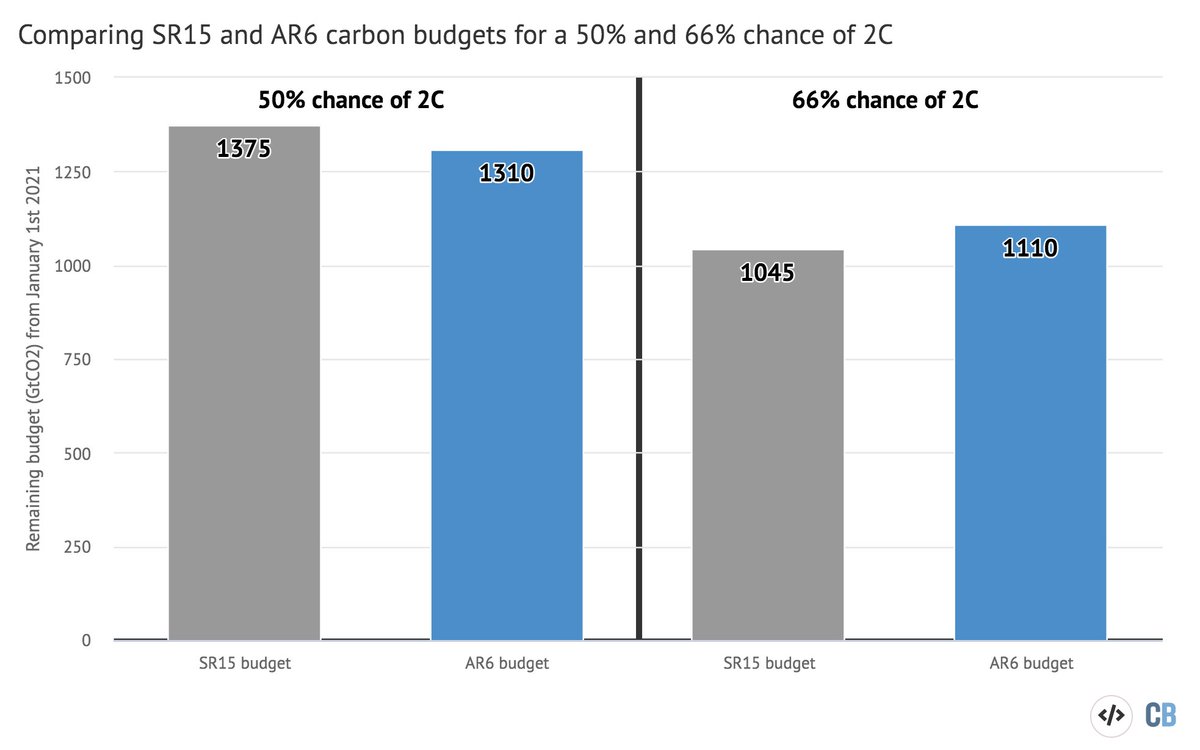
In my latest piece at @CarbonBrief, I take a deep dive into what the IPCC AR6 says about when the world will likely pass 1.5C and 2C, and how the new estimates of the remaining carbon budgets compare to those in the 2018 IPCC SR15 special report: carbonbrief.org/analysis-what-… 1/14
When we talk about passing a particular warming level like 1.5C or 2C we are not referring to an individual year (or month). Any given year may be ~0.2C warmer or cooler than average due to natural variability from El Nino and La Nina events. 2/
The AR6 reports on the 20-year period in which temps exceed 1.5C (e.g. 2021-2040), and suggests using the midpoint of that range (e.g. 2030) as the year when long-term average temps passes that level. We used a similar approach in an earlier analysis: carbonbrief.org/analysis-when-… 3/
The AR6 suggests we will most likely pass 1.5C between 2027 and 2035 depending on emissions scenarios, quite similar t values found in our 2020 @CarbonBrief analysis. Each scenario has a range of possible exceedance dates reflecting the uncertainty in climate model estimates 4/ 

These values are on the early end of the range of possible exceedance dates given in Chapter 1 of the 2018 IPCC SR15 report, but are quite consistent with estimates provided in Chapter 2. realclimate.org/index.php/arch… 5/
Some scenarios (SSP1-1.9 and SSP1-2.6) have a chance of never reaching 1.5C warming in the 21st century, even though the odds of doing so are less than 50% (and very small for the relatively higher emissions SSP1-2.6 scenario). 6/
There are, however, other scenarios in the literature that were featured in the SR15 report that avoided overshoot, though they required even more stringent near-term emissions reductions than those in the already quite ambitious SSP1-1.9 scenario. 7/
This figure shows the range of possible exceedance years for 2C in the new IPCC report, alongside our earlier Carbon Brief estimates: 8/ 

The AR6 also provides an updated carbon budget. They make a number of changes: higher estimates of historical warming, lower estimates of differences between surface air temp and sea surface temp warming rates, inclusion of earth system feedbacks, and an updated TCRE range. 9/
The net effect of all of these changes is a carbon budget largely in-line with the carbon budget found in the IPCC SR15 report for a 50% chance of limiting warming to 1.5C. Note that these remaining carbon budgets are updated through the start of 2021: 10/ 

There are more notable differences in carbon budgets remaining for a 66% chance of limiting warming to below 1.5C. In this case the AR6 actually increased the carbon budget modestly, a result of a narrowed range of climate sensitivity (and associated TCRE) in the new report. 11/
The remaining carbon budget for 2C is similarly mostly unchanged for a 50% avoidance chance relative to the SR15 report, but a bit larger for the 66% avoidance chance: 12/ 

While these carbon budgets are broadly similar to the ones in the 2018 SR15 report, they are much larger than similar carbon budgets in the 2013 IPCC 5th Assessment Report (AR5). For a deep dive into why see our article here: carbonbrief.org/analysis-why-t… 13/
For more technical details on these changes, read our detailed analysis over at @CarbonBrief: carbonbrief.org/analysis-what-…
And check out this excellent deep-dive by IPCC lead author @JoeriRogelj:
And check out this excellent deep-dive by IPCC lead author @JoeriRogelj:
https://twitter.com/JoeriRogelj/status/142474378264643994414/
• • •
Missing some Tweet in this thread? You can try to
force a refresh






